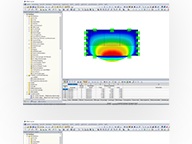Rigid Joints According to EN 1993-1-8
RF-/JOINTS Steel - Rigid | Features
General
- Beam to Column joint category: connection possible as joint of the beam to the column flange as well as joint of the column to the girder flange
- Beam to Beam joint category: design of beam joints as both moment-resisting end plate connections and rigid splice connections possible
- Automatic export of model and load data possible from RFEM or RSTAB
- Bolt sizes from M12 to M36 with strength grades 4.6, 4.8, 5.6, 5.8, 6.8, 8.8, and 10.9 as long as the strength grades are available in the selected National Annex
- Almost any bolt spacing and edge distances (a check of the allowable distances is performed)
- Beam strengthening with tapers or stiffeners on the top and bottom surfaces
- End plate connection with and without overlap
- Connection with pure bending stress, pure normal force load (tension joint), or combination of normal force and bending possible
- Calculation of connection stiffnesses and check if a hinged, semi-rigid, or rigid connection exists
End plate connection in a beam-column setup
- Joint beams or columns can be stiffened with tapers on one side or with stiffeners to one or both sides
- Wide range of possible stiffeners of the connection (for example, complete or incomplete web stiffeners)
- Up to ten horizontal and four vertical bolts possible
- Connected object possible as constant or tapered I-section
- Designs:
- Ultimate limit state of the connected beam (such as shear or tension resistance of the web plate)
- Ultimate limit state of the end plate at the beam (for example, T-stub under tensile stress)
- Ultimate limit state of the welds at the end plate
- Ultimate limit state of the column in the area of the connection (for example, column flange under bending – T-stub)
- All designs are performed according to EN 1993-1-8 and EN 1993-1-1
Moment-resisting end plate joint
- Two or four vertical and up to 10 horizontal bolt rows
- Joint beams can be stiffened with tapers on one side or with stiffeners to one or both sides
- Connected objects are possible as constant or tapered I-sections
- Designs:
- Ultimate limit state of the connected beams (such as shear or tension resistance of the web plates)
- Ultimate limit state of the end plates at the beam (for example, T-stub under tensile stress)
- Ultimate limit state of the welds at the end plates
- Ultimate limit state of the bolts in the end plate (combination of tension and shear)
Rigid splice plate connection
- For the flange plate connection, up to ten bolt rows one behind the other possible
- For the web plate connection, up to ten bolt rows possible each in vertical and horizontal directions
- Material of the cleat can be different from the one of the beams
- Designs:
- Ultimate limit state of the joint beams (for example, net cross-section in the tension area)
- Ultimate limit state of the cleat plates (for example, net cross-section under tensile stress)
- Ultimate limit state of the single bolts and the bolt groups (for example, shear resistance design of the single bolt)
RF-/JOINTS Steel - Rigid | Input
After starting the module, the joint group (rigid joints) is selected first, followed by joint category and joint type (rigid end plate connection or rigid splice plate connection). The nodes to be designed are then selected from the RFEM/RSTAB model. RF-/JOINTS Steel - Rigid automatically recognizes the joint members and determines from its location whether they are columns or beams. The user can intervene here.
If certain members are to be excluded from the calculation, they can be deactivated. Structurally similar connections can be designed for several nodes at the same time. Loads require selection of the governing load cases, load combinations, or result combinations. Alternatively, you can enter the cross‑section and load data manually. In the last input window, the connection is configured step by step.
RF-/JOINTS Steel - Rigid | Design
Die Bemessung erfolgt gemäß EN 1993-1-8 und EN 1993-1-1. Die Schnittgrößen werden direkt im vorgegebenen Knoten angenommen. Bei Träger-Stützen-Anschlüssen entstehen somit zusätzliche Exzentrizitäten zur Anschlussebene, welche in der Berechnung berücksichtigt werden. Neben der Bemessung der ausreichenden Tragfähigkeit des Anschlusses erfolgt eine Berechnung und Einstufung der Verbindung hinsichtlich der Steifigkeit.
RF-/JOINTS Steel - Rigid | Results
In den Ergebnismasken werden detailliert sämtliche Ergebnisse der Berechnung aufgelistet. Zudem wird eine dreidimensionale Grafik erstellt, in der einzelne Komponenten sowie Maßlinien und z. B. Schweißnahtangaben ein- und ausgeblendet werden können. In der Ergebniszusammenfassung ist sofort erkennbar, ob die einzelnen Nachweise erfüllt sind oder nicht. Zudem werden Knotennummer und maßgebender Lastfall bzw. die maßgebende Last- oder Ergebniskombination angegeben.
Bei Auswahl eines Nachweises werden detaillierte Zwischenergebnisse einschließlich der Einwirkungen und zusätzlichen Schnittgrößen aus der Anschlussgeometrie eingeblendet. Zusätzlich besteht die Möglichkeit, sich die Ergebnisse lastfallweise und knotenweise anzeigen zu lassen. Das 3D-Rendering ist eine wirklichkeitsgetreue und maßstäbliche Darstellung der Verbindung. Neben den Hauptansichten kann die Grafik aus jeder beliebigen Perspektive betrachtet werden.
Die Grafiken können einschließlich der Bemaßungen und Beschriftungen in das RFEM-/RSTAB-Ausdruckprotokoll eingebunden oder als DXF exportiert werden. In diesem werden alle Eingabedaten und Ergebnisse prüffähig ausgegeben. Sämtliche Modultabellen können problemlos nach MS-Excel oder in eine CSV-Datei exportiert werden. Ein Übergabemenü regelt hier alle notwendigen Exportangaben.
Calculate Your Price
_(2).png?mw=400&hash=a9760ec7cb2b22d413eb543d6d5899a4fb213ca0)
The price is valid for United States.


_(2).png?mw=1024&hash=7cae39e82a244a5cce6a2ea51b2f5683dd969a21)





.png?mw=192&hash=f63e4a3f1836233005de32f60201d5392e507cf1)



